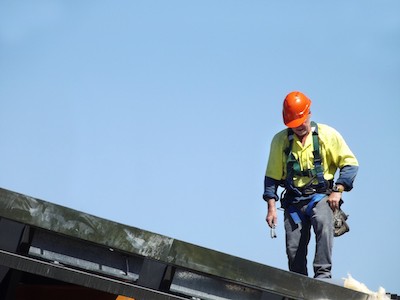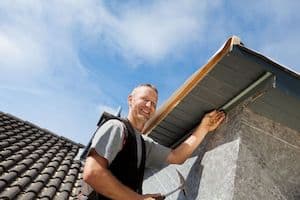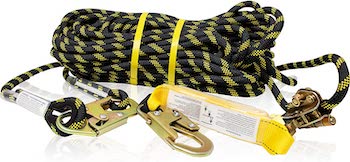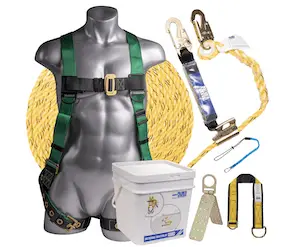Today we’re going to cover 7 ways to stay safe when working on a roof.
A roof will need repairs every handful of years, not to mention any time it sustains damages during a rough storm. Sometimes it’s wisest to contact and hire alocal roofing professional, while at other times it may seem easier to just get the job done yourself.
So how do you stay safe when working on your roof? You can stay safe while working on a roof by having someone else nearby while you’re working, making sure you have the proper equipment and that it’s all in good working order, and only working on a roof in favorable weather conditions.
While these are the general guidelines you should follow in order to stay safe, there’s still a lot more you can do to ensure your safety. In this article, we’re going to dive into some of the most important aspects of roof repair safety so that you can tackle your next roofing project with confidence.
Important Safety Practices for Repairing a Roof
Roof repairs can get pricey depending on the extent of the damage that you’re fixing. For a major repair, some buyers can expect to pay upwards of $3,000. It’s easy to understand why if you’re reading this that you may be interested in doing the repairs on your own.
You can save a significant amount of money by handling your own repairs but you shouldn’t move with haste at the expense of your safety.
It is reported that 6 roofers pass away on average every month in the United States from falling. Here are a couple of valuable safety precautions to take into consideration before you break out the ladder and possibly wind up breaking your leg in the process.
1. Implement Ladder Stability and Safety Techniques
Stepping onto a ladder to get onto your roof or to descend to the ground can be both precarious and unnerving. By following these steps you can have some confidence in your safety while using ladders.
Now, the first thing you need to do upon setting your ladder up is to inspect it for damage. If you notice that something is off, address it immediately.
If it appears to be in good condition for safe use then the next step to stabilize it in the area you will be using it. While this may seem fairly simple, it is absolutely crucial to do everything within your power to avoid a fall. Here is a list you can use to double-check your ladder’s stability:
- Set up your ladder on solid footing. If the ground is not level, you can place squares of plywood under one of the feet and then reinforce it with wire and stakes.
- Set your ladder against a sturdy backing. You can also reinforce the top of your ladder with wire for extra security. The bottom of the ladder should stick out about one foot away from the house for every 4 feet of elevation.
- Once your ladder has been stabilized, raise the top of it to extend a minimum of 3 feet above the edge of your roof. This allows you to have a firm grip as you dismount from the ladder and onto your roof.
- When you begin to climb up your ladder face the ladder. Use one step at a time keep either 2 feet or 2 hands on a step, maintaining a total of 3 points of bodily contact at all times.
- When you are working for multiple days at a time, refrain from leaving your ladder unattended at night. You can remove it completely or simply lock it on the ground. This protects local children who may be playing in the area from getting injured.
- Utilize a ladder stabilizer to maintain balance.
The weather plays an important role when it comes to repairing a roof. It might seem obvious enough to avoid doing repairs in weather conditions such as ice, snow, and high winds.
However, there are a few other weather hazards to watch out for. Rain can pose a threat even if you think you have sure footing. It is risky to work on a slick surface. Humidity can also make surfaces slippery.
In addition, the hot summer sun can soften the shingles and leaves them susceptible to further damage. Extremely warm weather also poses the threat of heat-related illnesses that can potentially be worse than falling. So it’s best to check ahead of time and plan your workday around cool and calm weather.

 3. Prepare Your Workspace
3. Prepare Your Workspace
Do this by wearing the appropriate roof repair attire, gathering all the supplies you will need, and taping off the area. Your work attire should consist of appropriate shoes and a tool belt to assist you in keeping track of your tools.
We will go more in-depth about the specific supplies you may need at the end of this article. You will be able to reduce the hassle of having to get on and off the roof multiple times by being properly prepared, and thus decrease the chances of an accident.
Taping off the area you will be working is an important safety procedure that makes passerby’s below aware that you’re working above them. And just an extra tip: you should never forget to call out before you toss anything over the edge.
4. Improve Your Roof Safety By Utilizing a Fall Protection Method
Hopefully, when you put the previous safety measures mentioned into practice, you should be able to avoid all the major causes of falling off your roof. However when it comes to falling, there a few systems specifically manufactured to offer even more protection. By including any one of these systems in your repair project, you can create a secondary safety net that will help you work more freely. You can utilize an OSHA & ANSI compliant construction fall arrest kit for roofers.
5. Utilize Guardrails to Prevent Falls
Guardrails are a solution typically provided for during a roof repair that is conducted over a larger surface area. This might be the answer for you if you are seeking fall protection for a project on a large commercial roof. Guardrails are one of the more cost-effective choices and are considerably simple to set up.
6. Install a Fall Restraint Mechanism
Fall restraint mechanisms are a different system geared towards protecting workers from tumbling over a roof edge. These come in a wide variety of forms such as anchors, tracks and lifelines. By restraining the worker from getting too close to the edge, falls become much less of a worry.
 7. Fall Arrest Systems or Safety Harness
7. Fall Arrest Systems or Safety Harness
Fall arrest systems can sometimes be the least preferred option of fall protection because they intend to stop a fall after it is already happening. Often times, these devices require training and practice in order to use properly. Fall arrest systems are most helpful when a worker has to safely reach a repair on a roof edge.
While some of these systems may be ideal for some workers than others, it still remains to be true that adding even one method of fall protection into your work environment will greatly increase your level of safety overall.
Hazards that may lead to a greater requirement of fall protection can be specific circumstances where working on a roof requires working around skylights or multi-level roofs and edges.
![]()
More Roofing Safety Supplies and Tips
When you have all the supplies you will need on hand ahead of time, you can prevent getting on and off of your roof more times than should normally be necessary. The more efficient you work, the less of a risk you have of falling. With that being said, here is a list of some of the handiest supplies to gather before you begin working on your roof:
- Nonslip shoes– Investing in suitable footwear that gives you more grip under your feet can make the difficult and dangerous job of roof repair a little bit easier.
- Crowbar – crowbars are beneficial to have readily available for hard to reach nails that can sometimes be difficult or impossible to remove by hand.
- Shovel – A flat head shovel is a practical tool that is put to good use when removing existing roof shingles.
- Roofing Tarp – When your repairs get interrupted by inclement weather, using a tarp will prevent your handy work from getting soaked as well as blocking water from entering the building through pre-existing leaks.
- Chalk line – Use a chalk line to avoid laying crooked lines. Easily snap a pattern and fill it in.
Rather than taking multiple trips up and down your ladder to transfer your tools, grab a buddy along with a rope and a bucket. By make shifting a pully system, one of you can climb on the roof while the other passes supplies from below.
If you have any doubts, reach out to your local home improvement store for additional information and advice. As we said before, and want to reiterate one more time, it is imperative that you have a helper or two standing nearby.
In this case, it’s always better to work as a team! At the end of the day, the safest protocol unquestionably is enlisting the help of a roofing professional. So do your best out there while you work on your roof and never be afraid to ask for help when you need it.





